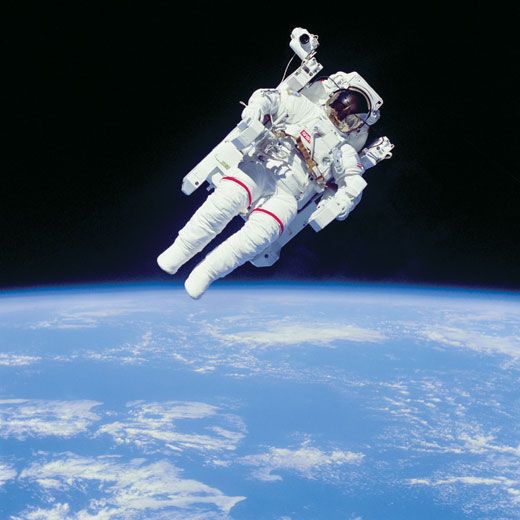Footloose
The image of Bruce McCandless’ spacewalk two decades ago still amazes. It was the first untethered walk everand was among the last
/https://tf-cmsv2-smithsonianmag-media.s3.amazonaws.com/filer/indelible_crew.jpg)
It may not have been a giant leap for mankind, but Bruce McCandless II took an awfully big step on February 7, 1984, when he ventured out of the shuttle Challenger and became the first person to fly freely in space, untethered to a craft. Strapped into a jet pack, McCandless traveled more than 300 feet from the mother ship, with the blue Earth glowing 150 nautical miles below. Inside the shuttle, Robert Gibson peered through a Hasselblad camera lens. "Holy smokes," Gibson recalls thinking, "what an image this is."
Today, the photograph that Gibson took is as astonishing as ever, ranking among NASA's top five or six most-requested images. McCandless calls it "an icon for human triumph over gravity or triumph over nature." But the picture is also poignant, in that the boundless optimism it captured has been tempered by tragedies and dead ends. NASA curtailed the shuttle program after the Challenger exploded in January 1986, and no shuttle has flown since the Columbia disaster two years ago this past February. (At press time, the Discovery was scheduled for a launch in mid-July.) And not long after McCandless inspired countless space-travel fans by becoming the first "human satellite," NASA discontinued the jet pack that had made his extraterrestrial jaunt possible.
McCandless joined NASA's astronaut corps in 1966, and served 24 years. A Navy aviator with a master's degree in electrical engineering, he spent nearly 18 years working Earthbound posts, including ground-to-space radio communications at Mission Control in Houston. And he helped mastermind the jet pack device, known as the manned maneuvering unit, or MMU. "Nobody has left his stamp on any instrument in space like Bruce has left his mark on the backpack," NASA's Charles Whitsett, who headed the MMU design team (and died in 1993) told the Washington Post. The device was developed to help astronauts repair or retrieve orbiting satellites.
Not that spacewalking was new. Russian cosmonaut Alexei Leonov took the first walk in space in March 1965, followed three months later by American astronaut Ed White—but both were tied to their spacecraft. The notion of an untethered astronaut hurtling through space at some 17,500 miles per hour stirred excitement and alarm. It would be "the most dangerous space shuttle mission ever," the Post reported in 1984. McCandless, now 68, says he took comfort in his insider knowledge of the MMU's safeguards: "I had made up my mind before launch that if I didn't think that it was worth the risk, then I should go somewhere else and get a different job."
McCandless spent a little more than an hour free-flying the first time out—ever the engineer, he would describe it merely as a "thrill"—and went on to log another three untethered hours on the eight-day mission. Crew mate Robert Stewart also took the MMU for a drive, as did four other astronauts on shuttle flights later that year. But NASA dropped the MMU after 1984, in part because astronauts could perform the same tasks with the shuttle's robotic arm. Today, astronauts aboard the International Space Station wear a small, modified version of the device on spacewalks in case of an emergency.
During McCandless' first MMU flight, Gibson, the shuttle pilot, could not stop checking light readings and focus settings, he recalls: "I said, if I don't mess this up, I will get an Aviation Week cover with this picture." (He got two.) Now 58, he's a captain for Southwest Airlines and lives in Tennessee with his wife, the former astronaut Rhea Seddon, and the younger two of their four children. He marvels that the McCandless picture, called Backpacking by some, "just won't go away."
Since leaving NASA, McCandless has worked as a senior research scientist with Lockheed Martin Space Systems in Littleton, Colorado. He had been developing a machine to repair the ailing Hubble Space Telescope—an instrument he helped launch from a shuttle in 1990 and that is due to peter out around 2008. Does he find it ironic that the human satellite himself has been working on a robot to perform what many argue is an astronaut's job? Not at all. He says that a mix of human and robotic effort is the most effective approach in space. Still, NASA recently jettisoned McCandless' robotic project as overly complex. The agency is weighing a shuttle mission to service Hubble.
McCandless, who lives in Conifer, Colorado, with Bernice, his wife of 45 years, says a goofy version of the famous photograph of him hangs in their home. It shows their grown daughter poking her head through the cut-out visor in a life-size reproduction at a Seattle space museum. The subject's anonymity, he says, is its best feature: "I have the sun visor down, so you can't see my face, and that means it could be anybody in there. It's sort of a representation not of Bruce McCandless, but mankind."
